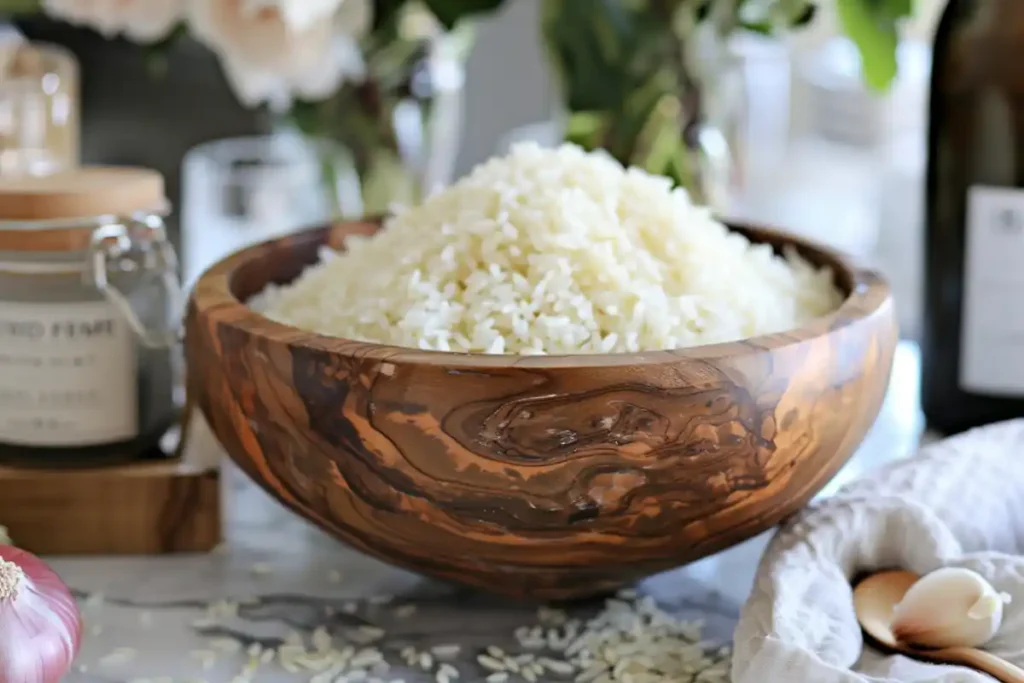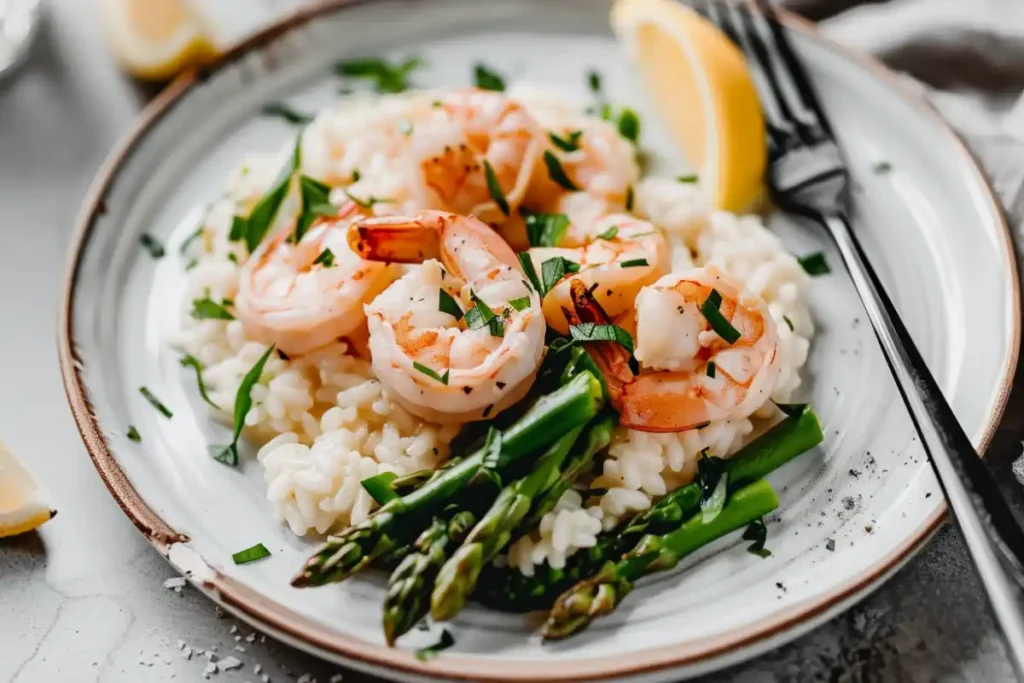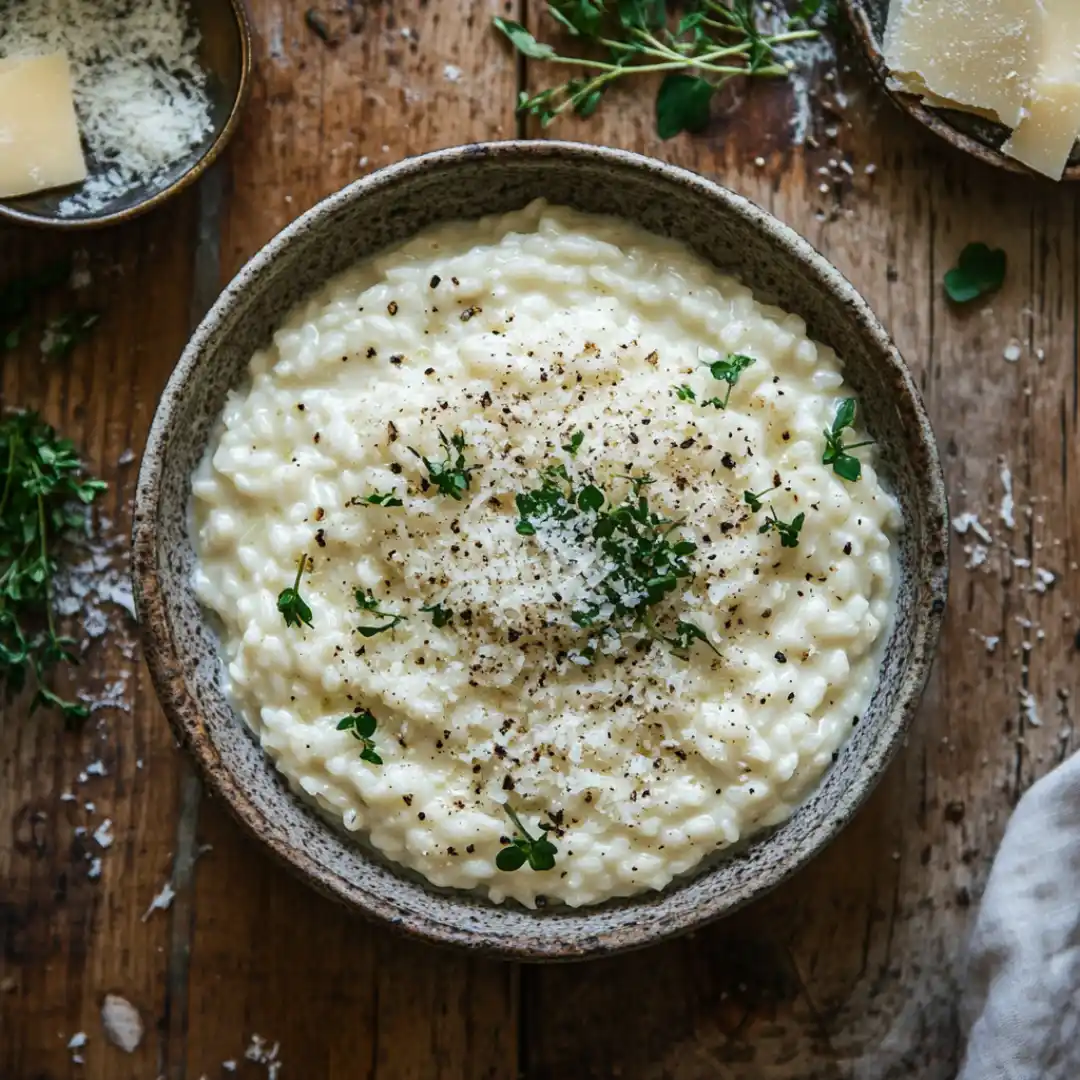Creamy, rich, and oh so satisfying, risotto is one of those comfort foods that just hits the spot. But if you’re living that gluten free life, or have celiac disease or gluten sensitivity, you’ve probably paused mid bite and wondered: is risotto gluten free?
Well, you’re in the right place! In this guide, we’ll dive deep into everything you need to know about risotto and gluten. From its ingredients to hidden gluten culprits, restaurant tips, and even homemade gluten free risotto recipes, this article’s got you covered. Plus, we’ll explore healthy swaps, nutritional facts, and common questions people also ask.
Let’s dig in, shall we?
What is Risotto and Its Core Ingredients?
Understanding the Origins of Risotto
Risotto isn’t just fancy rice, it’s a Northern Italian masterpiece. Traditionally cooked slowly with broth, this dish is stirred gently until the rice becomes rich, velvety, and oh so creamy. But here’s the kicker: risotto isn’t pasta. It may be served in Italian restaurants alongside pasta, but risotto is actually made from short-grain rice.
The most common type? Arborio rice. But if you’re fancy (or just curious), there’s also Carnaroli and Vialone Nano, all of which have a high starch content that gives risotto its signature texture. And guess what? These rice types are naturally gluten free. Score one for the gluten sensitive crowd!
Typical Ingredients in Classic Risotto Recipes
The base of any risotto is pretty simple: rice, broth, and a whole lot of stirring. From there, it’s a blank canvas for delicious add ins. Think butter, Parmesan cheese, onions, garlic, white wine, and sometimes meats or veggies.
But here’s where things get tricky. While the rice is safe, some extras, like store bought broth, flavored seasonings, or even pre shredded cheese, can sneak in some gluten. That’s why checking labels or cooking from scratch is key if you’re trying to keep your meal 100% gluten free.
Oh, and don’t be fooled by the term “glutinous rice.” Despite the name, it contains zero gluten. It’s just called that because of its sticky texture, not because it’s dangerous for gluten-free eaters.
So far, so good, right? But there’s more to the story than just rice. Let’s keep going to find out when risotto might not be gluten free.
Is Risotto Gluten Free by Default?

The Gluten Free Nature of Arborio and Other Risotto Rice Varieties
Let’s set the record straight, rice is naturally gluten free. That includes the star players of risotto: Arborio, Carnaroli, and Vialone Nano. These Italian short-grain rice varieties are naturally safe for anyone on a gluten-free diet. So, if you’re asking is risotto gluten free right out of the pot, the answer is: yes, it absolutely can be.
But here’s where it gets spicy, Gluten free doesn’t always mean gluten safe. While the rice itself is fine, what happens to it along the way matters a lot. For example, rice that’s processed in facilities that also handle wheat could suffer from cross contamination. Yikes, right?
So, next time you’re grocery shopping, look for rice labeled certified gluten free, especially if you’re cooking for someone with celiac disease.
How Rice Differs from Gluten Containing Grains
There’s often confusion between rice and grains like wheat or barley. Unlike wheat, which does contain gluten, rice is a gluten free grain. Even when you hear terms like “glutinous rice”, don’t panic. That just refers to its sticky texture, not gluten content.
Gluten is a protein, and rice doesn’t have it. That’s what makes risotto such a great option for people steering clear of gluten. You still get that comforting, creamy texture without the bellyache.
Speaking of risotto styles, here’s a twist: some people like making risotto pasta for a creamier texture with short pasta shapes. If you’re curious, check out this creamy risotto pasta recipe and just be sure to sub in gluten-free pasta for a safe swap.
When Risotto Might Contain Gluten
Risks from Broths, Stocks, and Bouillon Cubes
Even though the rice is fine, things can go sideways real quick. One of the biggest gluten traps in risotto? The broth. Many store bought broths and bouillon cubes add flavor with wheat based additives or hydrolyzed wheat protein. Sneaky, huh?
So if you’re prepping risotto at home, make sure you double check the label on that broth box. Look for “gluten free certified” right on the packaging. When in doubt, homemade broth is always a safer bet. It’s tastier too!
Hidden Gluten in Flavorings, Thickeners, and Restaurant Add ins
Now let’s talk about eating out. Ordering risotto at a restaurant can be a game of ingredient roulette. Sure, the menu might say “mushroom risotto,” but what’s hiding behind the scenes?
Some kitchens use thickeners or pre made sauces that contain wheat flour or soy sauce (yes, some brands of soy sauce contain gluten!). Also, toppings like breadcrumbs or beer cooked meats can ruin the gluten-free party fast.
If you’re dining out, don’t be shy, ask your server if the risotto is made with gluten free ingredients. And yes, that includes the broth, seasoning blends, and even the cheese.
Worried about cheese too? Some pre grated cheeses include anti caking agents made with wheat. Wild, right? So if you’re making risotto at home, opt for freshly grated Parmesan to play it safe.
Now you can see why the answer to “is risotto gluten free” isn’t always a simple yes or no. It depends on the details. But don’t worry, we’re just getting started. Next up, we’ll show you how to make your own foolproof gluten-free risotto at home.
How to Make Gluten-Free Risotto at Home
Tips for Choosing Certified Gluten Free Ingredients
When you’re cooking from scratch, you’re in the driver’s seat. And that’s the best way to ensure your risotto stays safe and completely gluten free. First things first: double check every single ingredient. It might sound tedious, but it’s worth it.
Always start with certified gluten free rice. Arborio is the go-to for classic risotto, but make sure it comes from a trusted brand that avoids cross contact with gluten. Next, look at your broth. Whether it’s chicken, veggie, or beef, scan the label for hidden gluten like hydrolyzed wheat or malt flavoring.
Butter and cheese are usually safe, but as we mentioned earlier, pre shredded cheese may contain wheat-based anti caking agents. Your best bet? Shred it yourself. It tastes better too.
Wine can sometimes be tricky, though most white wines used in risotto are naturally gluten-free. Still, it’s smart to check the bottle or do a quick brand search online.
Substitutions for Cheese, Butter, and Other Dairy Products
Want a dairy free twist without losing the creamy magic? You’re in luck. Swap out butter for olive oil or a plant based spread. Instead of Parmesan, try nutritional yeast or a dairy free cheese brand that’s also certified gluten free.
Coconut cream or cashew cream can add that velvety finish you love in risotto. And with fresh herbs, roasted veggies, or seared shrimp, your dish can still sing with flavor.
So, is risotto gluten free when made at home? Absolutely, when you choose the right ingredients. In fact, making it yourself might be the safest (and tastiest) option out there.
Gluten Free Risotto Recipes to Try

Shrimp Risotto with Asparagus
Talk about fresh and springy! Shrimp risotto with asparagus is not only elegant, it’s also quick to whip up. Just sauté your shrimp in garlic and olive oil, toss in some blanched asparagus, and finish everything off with a splash of lemon. Add it to your creamy risotto base and boom, you’ve got a meal that’s gluten free and gourmet.
Pumpkin Risotto with Goat Cheese
Craving comfort food with a twist? Pumpkin risotto is the way to go. The creamy texture of pumpkin puree blends beautifully with Arborio rice, while tangy goat cheese adds a punch of flavor. Sprinkle in some sage or cinnamon to bring in cozy autumn vibes. And yep, it’s naturally gluten free when made from scratch.
Mushroom Cauliflower Risotto for Vegans
Going plant-based and gluten free? No worries. This vegan risotto skips dairy and meat but doubles down on flavor. Mushrooms bring umami, while riced cauliflower adds nutrients without skimping on creaminess. Use a splash of veggie broth, add garlic and thyme, and you’ve got yourself a hearty, healthy bowl.
Each of these recipes proves that the answer to is risotto gluten free can be a definite “yes”, when you’re in control. So go ahead, get creative in the kitchen. Risotto is your blank canvas, and there’s no limit to the gluten free goodness you can whip up.
Is Risotto Healthy? Nutritional Considerations
Macronutrients in a Basic Risotto Serving
Alright, let’s talk health. While risotto may feel indulgent, it can actually be a balanced meal, depending on how you make it. A typical serving of basic risotto made with Arborio rice, butter, and cheese provides about 300–400 calories. It’s mostly carbs, with a moderate amount of fat and protein.
Since Arborio rice is a white rice, it’s lower in fiber than brown rice. But it’s also easier on the stomach and works beautifully in creamy dishes. If you’re managing your carb intake, portion control is key, especially if you have diabetes or are watching blood sugar levels.
How to Balance Carbs, Fat, and Protein
Want to make your risotto more of a well rounded meal? Add protein like shrimp, chicken, or tofu. Stir in fiber rich veggies, think peas, spinach, or roasted butternut squash. And instead of going heavy on cheese and butter, use just enough to add flavor without overloading on saturated fat.
So, is risotto gluten free and healthy? Yes, it can be, especially when you make it from scratch and tweak the ingredients. It’s all about balance and being mindful of what goes into your pot.
Dining Out? How to Order Gluten Free Risotto Safely
Questions to Ask Your Server or Chef
Eating out should be fun, not stressful. But if you’re on a gluten free diet, it pays to be extra cautious. When you’re ordering risotto at a restaurant, don’t just assume it’s safe. Ask questions like:
- What kind of broth is used?
- Is the dish thickened with flour?
- Are any pre made sauces or mixes added?
- Is the cheese freshly grated?
These small details can make a big difference.
Risotto in Italian Restaurants: What to Avoid
Italian spots are risotto heaven, but they’re also pasta central. That means more chances for cross contamination. If the kitchen preps gluten rich pasta on the same surface or uses the same utensils, your “gluten free” risotto might not be so safe after all.
So, is risotto gluten free at restaurants? Sometimes yes, but only if they take precautions. When in doubt, call ahead or choose places that specialize in gluten free options. Better safe (and satisfied) than sorry!

Gluten-Free Shrimp Risotto with Asparagus
Equipment
- Large saucepan
- Wooden spoon
- Ladle
Ingredients
Main Ingredients
- 1 1/2 cups Arborio rice certified gluten-free
- 1 lb shrimp peeled and deveined
- 1 bunch asparagus trimmed and cut into 1-inch pieces
- 1 small onion finely chopped
- 2 cloves garlic minced
- 4 cups gluten-free chicken broth warmed
- 1/2 cup white wine gluten-free, optional
- 2 tbsp butter or dairy-free alternative
- 1/3 cup Parmesan cheese freshly grated (optional or dairy-free substitute)
- 1 lemon zest and juice
- salt and pepper to taste
Instructions
- Heat 1 tablespoon of butter in a large saucepan over medium heat. Add shrimp and cook for 2–3 minutes per side until pink. Remove and set aside.
- In the same pan, add the remaining butter, chopped onion, and garlic. Cook for 3–4 minutes until soft and fragrant.
- Stir in Arborio rice and toast for 1 minute. Pour in the white wine and cook until it mostly evaporates.
- Start adding warm broth one ladle at a time, stirring constantly. Let the rice absorb the liquid before adding more. Continue for about 18–20 minutes until rice is tender and creamy.
- While risotto cooks, blanch asparagus in boiling water for 2–3 minutes. Drain and set aside.
- Once the risotto is creamy, stir in cooked shrimp, asparagus, lemon juice, zest, and Parmesan. Season with salt and pepper to taste. Serve hot.
Notes
FAQs: People Also Ask
Is risotto gluten free at restaurants?
It depends. While the rice in risotto is naturally gluten free, restaurants often use broths, sauces, or thickeners that may contain gluten. Plus, cross-contamination is a big concern, especially in kitchens that also prepare pasta dishes. Always ask the staff about the ingredients and cooking methods used.
What is the best rice for gluten free risotto?
Arborio rice is the classic choice for risotto. It’s naturally gluten free and has the right starch content to give the dish its creamy texture. Other good options include Carnaroli and Vialone Nano, which are also safe for gluten free diets.
Can risotto be made dairy-free and gluten free?
Absolutely! You can make risotto without butter or cheese by using olive oil and dairy free alternatives like cashew cream or nutritional yeast. As long as you use gluten-free broth and other safe ingredients, the dish stays both dairy- and gluten-free.
Is glutinous rice used in risotto gluten free?
Despite the confusing name, glutinous rice contains no gluten. However, it’s not typically used for risotto. Risotto is made with short grain rice varieties that release just the right amount of starch when cooked slowly.
Conclusion: The Final Scoop on Gluten and Risotto
So, is risotto gluten free? Most of the time, yes! At its core, risotto is made with rice, which is naturally gluten free. But here’s the kicker: ingredients like broth, cheese, and add-ins can sneak in gluten if you’re not careful.
When made at home with certified gluten-free ingredients, risotto can be both safe and seriously satisfying. When dining out, always ask the right questions to avoid hidden gluten.
Whether you’re new to gluten free living or just love cozy meals, risotto is a delicious and versatile option worth adding to your rotation.
Now grab that spoon and stir up something good!
